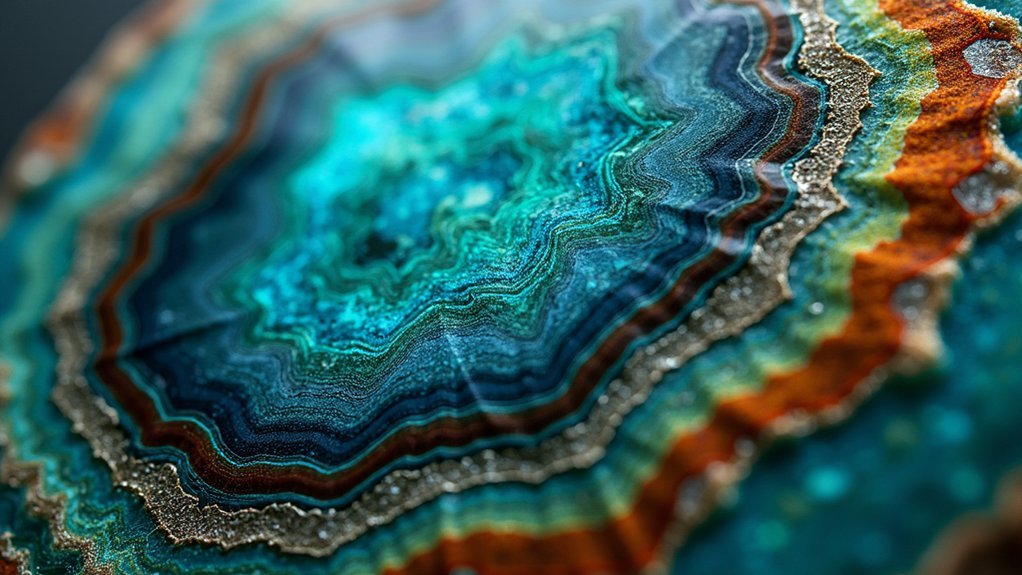Color zoning in gems matters because it affects both beauty and value. You’ll see variations like rings, stripes or patches that reveal the stone’s formation history. While even coloration typically commands premium prices, unique zoning patterns can authenticate natural gems and distinguish them from synthetics. Some collectors actively seek distinctive zoning in certain varieties like ametrine or tourmaline. Understanding these natural color distributions helps you appreciate the geological storytelling hidden within each crystal’s structure.
Defining Color Zoning in Gemstone Structure

Ribbons of color dancing through crystal structures create one of gemology’s most fascinating phenomena: color zoning. When you examine a gemstone closely, you’ll notice variations in color intensity and distribution throughout the stone. These patterns aren’t random—they tell the story of the gem’s formation, where different mineral inclusions and environmental conditions created distinct color regions.
Color zoning manifests in diverse patterns: concentric rings, angular sections, stripes, cloudy patches, or target-like formations. Each pattern contributes to a gemstone’s unique character and affects its color grading.
While some gems like ametrine and multicolored tourmaline are celebrated for their dramatic color zoning, others such as emeralds and sapphires are typically valued higher when displaying uniform coloration. Understanding these variations helps you appreciate both the science and artistry behind gemstones’ color.
The Science Behind Color Distribution in Crystals
The formation of a gemstone’s color zones begins at the atomic level, where nature conducts an intricate dance of elements under varying conditions.
As crystals grow, they incorporate chromophores—color-causing elements like chromium or manganese—at different rates and concentrations, creating the fascinating color zoning you’ll observe in many gems.
Mother Nature’s palette works through chromophores, painting gems with varied concentrations of elements that create their distinctive zoned appearance.
This distribution of color isn’t random but follows crystallographic patterns determined by temperature fluctuations, pressure changes, and the availability of trace elements during growth.
You’ll find concentric zones in tourmaline, angular patterns in sapphire, or straight bands in quartz, each telling a story of the gem’s formation.
When evaluating gems, professionals consider these color variations carefully during gemstone grading, as pronounced zoning can greatly impact both value and beauty of the finished stone.
Market Value Impact of Zoning Patterns

While some collectors cherish the unique character of color-zoned gemstones, most buyers in the marketplace will pay markedly less for stones with visible color irregularities. The more pronounced or eye-visible the color zoning, the greater the negative impact on a gem’s market value.
You’ll find that severe or unattractive distribution of color can dramatically depreciate a stone’s worth compared to its evenly-colored counterparts.
However, unique color zoning that creates interesting patterns might actually preserve value, particularly among collectors who appreciate natural authenticity indicators.
When valuing your gemstone, remember that comparisons with similar stones are essential, as market trends fluctuate based on buyer preferences. The final price always depends on what purchasers will actually pay—highlighting the subjective nature of gemstone valuation in today’s market.
Distinguishing Natural From Synthetic Through Zoning
Beyond market valuation considerations, color zoning serves as a powerful authentication tool in the gemological world.
When you’re examining a gemstone, these irregular color patterns offer critical clues about its origin. Natural stones typically display distinctive zoning patterns that tell the story of their formation over millions of years, while synthetic gemstones exhibit uniform coloration due to their controlled manufacturing environment.
You’ll notice professionals carefully analyzing these zoning characteristics during appraisals, as they’re key indicators of authenticity. This geological fingerprint not only helps distinguish natural from synthetic but often enhances the desirability of natural gems.
Collectors value these unique imperfections as evidence of a stone’s natural heritage—a stark contrast to synthetics, which lack these irregularities and consequently command only 1-3% of comparable natural stones’ prices.
Color Zoning as Geological Fingerprints

Each distinctive pattern of color zoning within a gemstone reveals a unique geological story, much like fingerprints identify an individual. When you examine these color variations, you’re actually seeing evidence of the temperature, pressure, and trace elements present during the stone’s formation.
These unique patterns serve as geological fingerprints that gemologists use to trace a stone’s origin. For instance, sapphires display distinctive zoning that indicates their formation location and surrounding mineral environment.
Concentric or striped zoning patterns not only enhance a gem’s character but make it more desirable to collectors.
In modern gemology, understanding color zoning contributes greatly to proper identification and valuation. By reading these natural patterns, you’re connecting with the stone’s formation history and appreciating its individual geological journey.
Professional Tools for Detecting Color Variations
To accurately identify and analyze color zoning in gemstones, professionals rely on sophisticated equipment that reveals details invisible to the naked eye.
Professional gemologists use high-powered magnification to examine internal characteristics and subtle color zoning patterns that might otherwise go undetected.
Spectroscopes play an essential role by identifying specific elements causing the color variations, helping experts understand the gem’s formation history.
When you’re having a stone evaluated, these professionals will also employ standardized color grading systems to guarantee consistent assessment of the variations.
For documentation purposes, techniques like photomicrography capture detailed images of color zoning, which serve as valuable references during valuation.
These advanced tools allow gemologists to thoroughly analyze color distribution, ultimately affecting how your gemstone is classified and priced.
Famous Gems and Their Distinctive Zoning Patterns

Some of the world’s most valuable gems owe their renown to distinctive color zoning patterns that tell stories of their formation.
You’ll find this phenomenon beautifully illustrated in treasures like the Hope Diamond with its boron-infused blue zones and the Blue Moon Diamond’s mesmerizing blue-gray shifts.
These exceptional specimens establish market benchmarks through their unique color distributions, setting standards that collectors and gemologists use to evaluate newly discovered stones.
Historic Zoning Showcases
Throughout history, certain gemstones have achieved legendary status not only for their size or provenance but for their remarkable color zoning patterns. The Hope Diamond exemplifies this phenomenon with its mysterious blue hues and darker zones that enhance its allure.
You’ll find similar value-adding characteristics in the Imperial Topaz, where well-defined golden-orange zones greatly boost its market value.
The Black Prince’s Ruby demonstrates how color zoning contributes to historical significance, with its striking red and pink variations enchanting observers for centuries.
Tanzanite’s blue-purple zoning creates visual effects that collectors enthusiastically seek.
Perhaps most impressive is the Ceylon Sapphire, where the harmonious distribution between deep and lighter blue zones creates an aesthetic balance that gemologists prize.
These historic examples show why color zoning remains a vital factor in determining a gem’s uniqueness and worth.
Market-Defining Patterns
While many gems possess color zoning, certain specimens have established industry benchmarks that define excellence in this characteristic. The “Blue Moon” diamond’s deep blue zoning, created by boron impurities, exemplifies how the distribution of color within a gem can elevate its market status.
Imperial Topaz showcases striking orange-to-pink shifts that collectors prize, often commanding thousands per carat.
Similarly, parti-colored Kashmir sapphires with their blue, yellow, and green combinations represent some of the most desirable zoning patterns in existence.
Tanzanite’s blue-purple zoning has become a market-defining feature, with exceptional specimens reaching $1,000+ per carat.
Among the factors that influence gem valuation, Colombian emeralds demonstrate how zoning can work both ways—uneven green distribution typically reduces value, while uniform coloration enhances desirability and collectability in the competitive gemstone market.
Cutting Strategies to Enhance or Minimize Zoning
When faced with color-zoned gemstones, skilled lapidaries employ strategic cutting techniques that can dramatically transform a stone’s appearance. Rather than cutting for maximum weight, experienced gem cutters prioritize ideal color presentation, carefully positioning facets to minimize undesirable zoning while highlighting attractive color zones.
You’ll find that strategic re-cutting can effectively hide excessive zoning, though this often comes at the cost of reduced carat weight.
The uneven distribution of color in rough material presents both challenges and opportunities—proper facet arrangement can convert what might initially appear as a flaw into a visually appealing gem. For stones like green tourmaline, employing steeper angles on end facets helps mute problematic zoning that might otherwise create an opaque appearance.
These cutting strategies ultimately determine whether color zoning becomes an asset or liability in your finished gemstone.
Color Zoning Across Different Gemstone Varieties

The expression of color zoning varies dramatically among gemstone varieties, creating both challenges and opportunities for collectors and jewelers alike.
While ametrine and tourmaline are celebrated for their distinct color boundaries, emeralds command higher prices when displaying uniform coloration without obvious regions.
Sapphires present fascinating complexity, where subtle color shifts can enhance their appeal, but stark zoning often diminishes value.
You’ll find diverse patterns across gemstones—from concentric rings to angular sections and striped formations—each contributing unique visual characteristics to the stone.
In tanzanite, blue-purple zoning typically adds character and value, whereas green patches in emeralds are generally considered flaws.
Today’s market increasingly appreciates distinctive color zoning in certain gemstone varieties, reflecting collectors’ growing desire for individuality over traditional uniformity.
Collector Appeal of Unique Color Distributions
You’ll find that gems with distinctive color zoning patterns command premium prices due to their scarcity and uniqueness in the marketplace.
These natural color distributions tell compelling geological stories that collectors cherish, revealing the stone’s formation conditions and crystallization journey.
When considering such specimens for your collection, weigh both their aesthetic appeal and potential appreciation value, as particularly striking examples often outperform uniformly colored stones in long-term investment returns.
Rarity Drives Desirability
Uniqueness in gemstones often transforms ordinary specimens into extraordinary treasures, particularly when it comes to color zoning patterns. The rarer the zoning configuration, the more desirable the gem becomes among discerning collectors.
When you’re examining gemstones with concentric or target zoning, you’re looking at specimens that nature has crafted through incredibly specific conditions—conditions that won’t be replicated exactly again. This inherent rarity drives up both demand and market value.
You’ll notice that color zoning creates natural fingerprints in gems, with collectors willing to pay premiums for these distinctive characteristics.
As market trends evolve, certain zoning patterns gain popularity, further increasing their desirability. What was once considered a flaw is now celebrated as evidence of a gem’s authentic, one-of-a-kind beauty.
Storytelling Through Patterns
Beyond mere aesthetic appeal, color zoning weaves a natural narrative throughout each gem’s structure. When you examine color-zoned gemstones, you’re witnessing millions of years of geological storytelling captured in unique patterns that make each specimen one-of-a-kind.
Collectors aren’t just purchasing stones—they’re acquiring tangible histories. The concentric rings or dramatic striped formations reveal formation conditions that create emotional connections with gem enthusiasts.
| Pattern Type | Storytelling Element | Collector Appeal |
|---|---|---|
| Concentric | Growth phases | Time capsule |
| Striped | Mineral intrusions | Geological diary |
| Sectored | Temperature changes | Climate record |
| Phantoms | Interrupted growth | Survival story |
Gemstones like ametrine and multicolored tourmaline command premium prices precisely because their distinctive color zoning isn’t viewed as imperfection—it’s celebrated as nature’s signature artistry, impossibly difficult to replicate.
Investment Value Considerations
While many traditional investors focus on clarity and carat weight, the collector market increasingly values gemstones with distinctive color zoning patterns for their investment potential.
You’ll find that stones displaying unique characteristics through color zoning often command premium prices compared to their uniform counterparts.
Consider parti-color sapphires, whose multiple color zones create visual complexity that can’t be replicated.
This uniqueness drives market demand among collectors seeking individuality in their acquisitions.
When you invest in gems with well-defined, attractive color zoning, you’re capitalizing on the growing appreciation for natural geological phenomena that synthetic stones can’t mimic.
The investment value of these distinctively zoned gemstones continues to rise as collectors recognize them as authentic signatures of nature’s artistry, making them not just beautiful possessions but potentially appreciating assets in a diverse investment portfolio.
Photography and Documentation Techniques for Zoning
Since color zoning represents one of the most distinctive characteristics of many gemstones, properly documenting these patterns requires specialized photographic techniques.
Using macro lenses will capture the intricate details of color zoning in your gemstones, while arranging proper lighting highlights variations without creating distracting glare.
Macro photography reveals gemstone color zoning in exquisite detail when paired with strategic lighting that accentuates patterns rather than overwhelming them.
Place your specimens against a white or neutral background to make zoning patterns more visible in your documentation.
Always photograph gemstones from multiple angles and orientations, as zoning appears differently depending on the stone’s position relative to light sources.
Include a scale or reference object in your high-resolution images to provide context for the gemstone’s size and the extent of visible zoning.
This thorough documentation approach enhances accurate assessment and helps you compare your specimens with grading standards.
Frequently Asked Questions
Why Do Gems Vary in Color?
Gems vary in color because you’ll find trace elements mix with minerals during formation. You’re seeing the results of crystallization processes where temperature, pressure, and environmental conditions create unique hues in each gemstone’s structure.
What Is Color Banding Gemstones?
Color banding in gemstones shows parallel lines of different colors within the stone. You’ll recognize these distinct bands as variations in mineral content that occurred during formation, creating beautiful patterns that tell the stone’s geological story.
What Is Color Zoning in Diamond?
Color zoning in diamonds occurs when you see uneven color distribution within a single stone. It’s considered a flaw that affects your diamond’s value, unlike colored gems where zoning can be desirable.
What Is Color Zoning in Sapphire?
Color zoning in sapphire occurs when you’ll notice uneven color distribution creating visible bands or patches within the stone. It’s a natural characteristic that can affect your sapphire’s value and aesthetic appeal.
In Summary
Color zoning isn’t just a quirk—it’s a window into a gem’s history. You’ll appreciate how these patterns affect value, authenticity, and cutting decisions. Whether you’re seeking perfection or celebrating nature’s variations, understanding zoning helps you make informed choices. As you examine gems, you’re not just seeing color variations; you’re witnessing geological storytelling captured in crystal, making each stone uniquely significant in your collection.





Leave a Reply